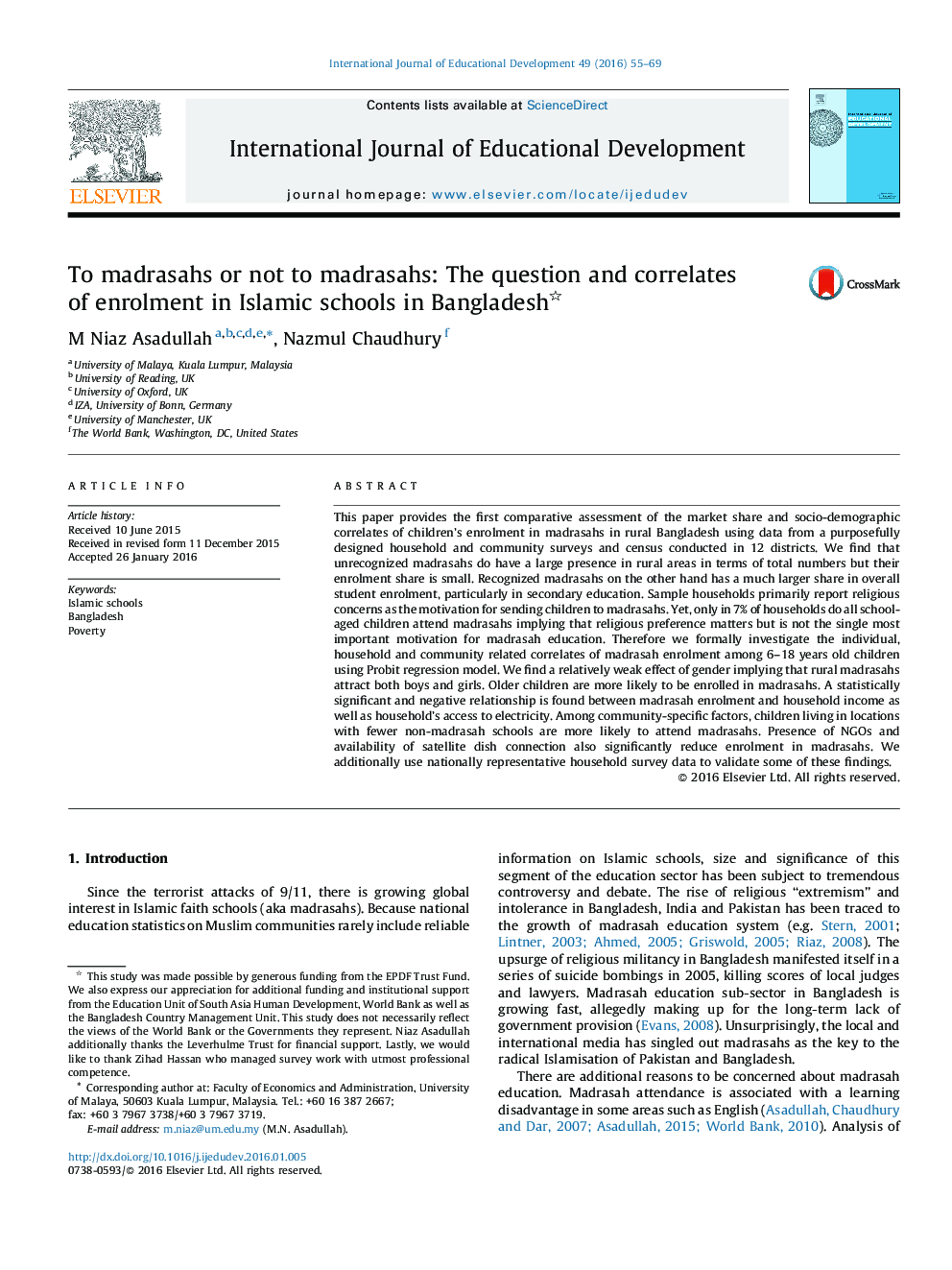| کد مقاله | کد نشریه | سال انتشار | مقاله انگلیسی | نسخه تمام متن |
|---|---|---|---|---|
| 6841199 | 1435097 | 2016 | 15 صفحه PDF | دانلود رایگان |
عنوان انگلیسی مقاله ISI
To madrasahs or not to madrasahs: The question and correlates of enrolment in Islamic schools in Bangladesh
ترجمه فارسی عنوان
به مدرسها و یا به مدرسه ها: سوال و همبستگی ثبت نام در مدارس اسلامی در بنگلادش
دانلود مقاله + سفارش ترجمه
دانلود مقاله ISI انگلیسی
رایگان برای ایرانیان
کلمات کلیدی
مدارس اسلامی، بنگلادش، فقر،
ترجمه چکیده
این مقاله اولین ارزیابی نسبی سهم بازار و همبستگی اجتماعی و جمعیت شناختی ثبت نام کودکان در مدرسها در بنگلادش روستایی را با استفاده از داده های حاصل از طرح های هدفمندانه خانه و جامعه، و سرشماری انجام شده در 12 ولسوالی ارائه می دهد. ما دریافتیم که مدرسان ناشناخته حضور زیادی در مناطق روستایی از لحاظ تعداد کل، اما سهم ثبت نام آنها کم است. از سوی دیگر، مدرساهای شناخته شده دارای سهم بسیار بیشتری در ثبت نام عمومی دانش آموزان، به خصوص در آموزش متوسطه هستند. خانوارهای نمونه در ابتدا نگرانی های دینی را به عنوان انگیزه برای ارسال کودکان به مدرسه ها گزارش می دهند. با این حال، تنها در 7 درصد از خانوارها، تمام کودکان مدرسه ای در مدرسه ها مشغول به تحصیل هستند که این موضوع را به اهمیت ترجیح مذهبی می پردازند اما مهمترین انگیزه برای آموزش مدرسه نیست. بنابراین، ما به صورت رسمی بررسی ارتباط همبستگی فردی، خانوادگی و جامعه در میزان ثبت نام مدرسه در میان کودکان 6-18 ساله با استفاده از مدل رگرسیون پروبیت انجام شد. ما یک اثر نسبتا ضعیف از جنس را پیدا می کنیم که نشان می دهد مدرسه های روستایی جذب پسر و دختر می شوند. بیشتر کودکان احتمالا در مدرسه ها ثبت نام می کنند. یک رابطه آماری معنی دار و منفی بین ثبت نام مدرسه و درآمد خانوار و دسترسی خانوار به برق وجود دارد. در میان عوامل خاص جامعه، کودکان شاغل در مدارس غیر مدرسه کمتر در مدارس حضور دارند. حضور سازمان های غیردولتی و دسترسی به ارتباطات ماهواره ای نیز باعث کاهش ثبت نام در مدارس می شود. ما بعلاوه از داده های نظرسنجی خانوارهای ملی استفاده می کنیم تا برخی از این یافته ها را تأیید کنیم.
موضوعات مرتبط
علوم انسانی و اجتماعی
علوم اجتماعی
توسعه
چکیده انگلیسی
This paper provides the first comparative assessment of the market share and socio-demographic correlates of children's enrolment in madrasahs in rural Bangladesh using data from a purposefully designed household and community surveys and census conducted in 12 districts. We find that unrecognized madrasahs do have a large presence in rural areas in terms of total numbers but their enrolment share is small. Recognized madrasahs on the other hand has a much larger share in overall student enrolment, particularly in secondary education. Sample households primarily report religious concerns as the motivation for sending children to madrasahs. Yet, only in 7% of households do all school-aged children attend madrasahs implying that religious preference matters but is not the single most important motivation for madrasah education. Therefore we formally investigate the individual, household and community related correlates of madrasah enrolment among 6-18 years old children using Probit regression model. We find a relatively weak effect of gender implying that rural madrasahs attract both boys and girls. Older children are more likely to be enrolled in madrasahs. A statistically significant and negative relationship is found between madrasah enrolment and household income as well as household's access to electricity. Among community-specific factors, children living in locations with fewer non-madrasah schools are more likely to attend madrasahs. Presence of NGOs and availability of satellite dish connection also significantly reduce enrolment in madrasahs. We additionally use nationally representative household survey data to validate some of these findings.
ناشر
Database: Elsevier - ScienceDirect (ساینس دایرکت)
Journal: International Journal of Educational Development - Volume 49, July 2016, Pages 55-69
Journal: International Journal of Educational Development - Volume 49, July 2016, Pages 55-69
نویسندگان
M Niaz Asadullah, Nazmul Chaudhury,
